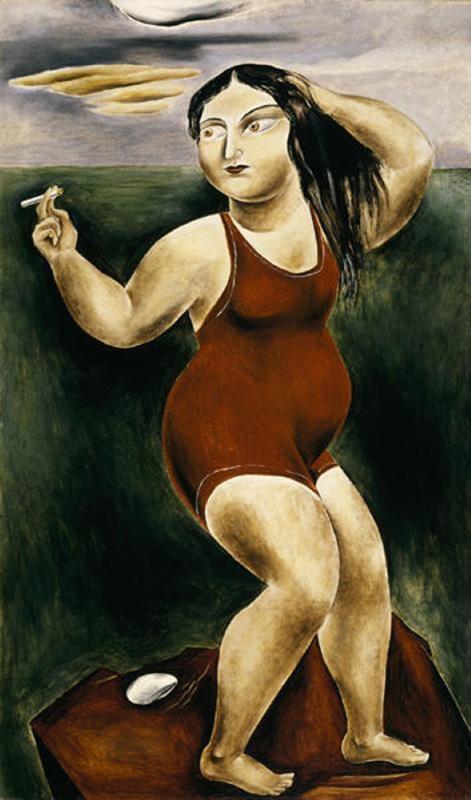More about Bather with Cigarette

Contributor
Bather with Cigarette is a humorous take on the newly relaxed behavioral codes in patriarchal 20th-century America.
Beaches are the ultimate escape from the pointless toil of everyday life, and oftentimes less so geographically than conceptually. Men and women alike not only strip themselves of their clothes, but also of socially acceptable behaviors and embarrassment. Dress codes are obliterated and the sunburn is worn as a status symbol of vacationing. The unselfconscious is transformed into one’s personal freedom and a stretch of sand becomes the stage of the absurd.
Artists from all fields and backgrounds have drawn inspiration from the endless hilarious scenarios that unfold on the beach, producing works that are not only great art but also entertaining. Bather with Cigarette, just like Kuniyoshi's other early paintings, is a humorous yet critical take on Western culture, seen through the eyes of someone who grew up in the East. Having immigrated to America from Japan in his teens, Kuniyoshi identified as American while his Japanese roots continued to shape his art. The result is a distinctive visual style influenced by American folk art, Japanese design, and European modernism.
As a prime example of the naive painting style of Kuniyoshi’s early works, Bather with Cigarette features simplified shapes, and distortions of scale and perspective, all painted in subtle earth colors. And of course, one of Kuniyoshi’s signature-style disproportionately bulky figures is not to be missed. In this case it happens to be a voluptuous bather in a tight-fitting one-piece bathing suit, who seems quite comfortable in her skin while enjoying a cigarette. For today’s standards it is a pretty unobtrusive appearance; for the time of the painting, it is not.
When swimming first became a popular leisure activity in the 18th century, women initially wore loose garments for bathing, and were discouraged from completely immersing themselves in the sea since it was considered unfeminine. Even though bathing attire experienced many changes over time, it was not until the early 20th century that dress codes were considerably relaxed. One-piece swimsuits were introduced, largely thanks to women finally being allowed to compete during the 1912 Olympics and a legal ruling that ill-fitting swimwear was not suitable for the sport.
However, with the swimsuits getting shorter and shorter, the patriarchal society became more and more concerned about vulgar behavior on their beaches. So in the 1920s, it was only a matter of inches that might have gotten you arrested for public indecency. The ‘swimsuit police’ and ‘beach censors,’ equipped with measuring tapes, roamed the seasides to look out for those immodest women, whose legs were exposed more than six inches above the knees. It led to the arrests of thousands of women. And even though men’s swimsuits looked quite similar to women's, they unsurprisingly received less critical attention.
But immodest clothing was not the only vulgar behavior to which the liberal women of the 20th century subjected the public. Smoking was just as bad and considered a symbol of prostitution. Here again the 1920s was a turning point and the cigarette industry targeted women through a propaganda campaign to increase the percentage of female smokers, and quite successfully at that.
With Bather with Cigarette and his many other beach life depictions, Kuniyoshi may be something like the Martin Parr of the 1920s, the woman in the one-piece swimsuit with cigarette as the equivalent of the beer-bellied and bare-breasted sunbathers of modern times. But more than being a satirical depiction, Kuniyoshi’s image shows a moment in history, and the notion of liberation in 20th century patriarchal America.
Sources
- “Bather with Cigarette.” Dallas Museum of Art. Accessed on August 23, 2022. https://collections.dma.org/artwork/4111498
- Cash, Sarah. “Yasuo Kuniyoshi.” National Gallery of Art. September 29, 2016. https://www.nga.gov/collection/artist-info.2600.html
- Crossen, Cynthia. “Women and smoking share checkered history.” Chicago Tribune. March 12, 2008. https://www.chicagotribune.com/news/ct-xpm-2008-03-12-0803100316-story…
- Duggan, Bob. “Between Two Worlds: The Unveiling of Yasuo Kuniyhoshi.” July 26, 2015. https://bigthink.com/culture-religion/between-two-worlds-the-unveiling-…
- Formichella, Janice. “Swimsuit Police to the Rescue.” Recollections. June14, 2020. https://recollections.biz/blog/swimsuit-police-to-the-rescue/
- Francis, Jaqueline. “Making Race: Modernism and Racial Art in America.” (Seattle, London: University of Washington Press:2012) p. 140.
- Harris, Karen. “When Women Could Be Arrested For Wearing The Wrong Swimsuit.” History Daily. Accessed on August 26, 2022. https://historydaily.org/bikini-laws-when-women-arrested-wearing-wrong-…
- Ibbetson, Fiona. “A History of Women’s Swimwear.” Fashion History. September 24, 2020. https://fashionhistory.fitnyc.edu/a-history-of-womens-swimwear/
- Levin, Gail. “Between Two Worlds: Folk Culture, Identity, and the American Art of Yasuo Kuniyoshi.” Archives of American Art Journal 43, no. 3/4 (2003): 2-17.
- Robert, Henry. “Yasuo Kuniyoshi, an American-Japanese Artist until Death.” September 30,2021. https://pen-online.com/arts/yasuo-kuniyoshi-an-american-japanese-artist…
- Sims, Josh. “The History of Men’s Swimwear.” The Rake. May 2018. https://therake.com/stories/history-mens-swimwear/
- “The Artistic Journey of Yasuo Kuniyoshi.” Smithsonian American Art Museum. Accessed on August 23, 2022. https://americanart.si.edu/exhibitions/kuniyoshi
- “Women being arrested for wearing one piece bathing suits, 1920s.” Rare Historical Photos. Updated November 26, 2021. https://rarehistoricalphotos.com/women-arrested-bathing-suits-1920s/#:~….
- Women in Bathing Suits being Arrested.” Encyclopedia.com. Accessed on August 23, 2022. https://www.encyclopedia.com/law/educational-magazines/women-bathing-su…











